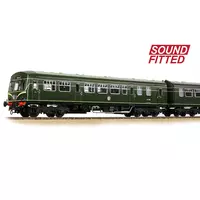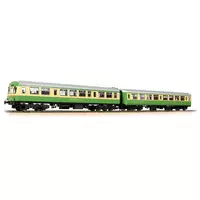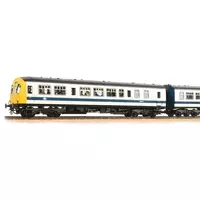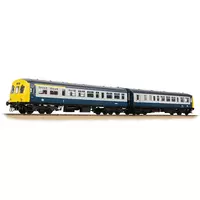Manufacturer catalogue image - please note that pre-release images may be CAD renders or CGI images rather than photographs
Prototype Era
Era 5 (1957 to 1966) British Railways Late Crest
Manufacturer description
The iconic Class 101 DMU returns for 2022 and this example is finished in the classic BR Green livery.
Our model of the Class 101 two-car Diesel Multiple Unit (DMU) captures the character of these first generation DMUs to a tee. Featuring detailed bodywork and interiors, the bogies have been finely rendered and all of the chassis-mounted equipment is present and correct too. All of these details are highlighted by the exquisite livery application, using BR-specification colours and authentic numbers and logos to produce a multiple unit fit for any British Rail fleet.
This two-car unit features a conductive coupling between the two vehicles meaning that a single DCC decoder is required for use on DCC, whilst space is provided for a speaker should you wish to fit sound to your model. Easier still, choose our SOUND FITTED model and you can enjoy realistic sounds on both Analogue and DCC straight out of the box.
MODEL FEATURES:
- Bachmann Branchline OO Scale
- Era 5
- Pristine BR Green (Roundel) Livery
- 2-Car Unit comprising DMBS No. SC51231 and DTCL No. SC56389
- Headcode B and Destination Blinds for Perth and Dundee Tay Bridge
- Accessory Pack
- NEM Coupling Pockets
- Powerful 5 Pole Motor with Flywheel
- Sprung Buffers
- Directional Lighting and Illuminated Destination Blinds
- Interior Lighting
- Ready to Accept a Speaker
- Equipped with a 21 Pin DCC Decoder Socket – recommended Decoder item No. 36-557
- Length 495mm
CLASS 101 DMU HISTORY
The Class 101 Diesel Multiple Unit (DMU) was one of the most numerous and widely used types of all the first generation DMUs. Typically formed into two-, three- or four-car sets, the first examples were introduced in 1956 and more than 600 vehicles, including driving vehicles fitted with a cab at one end and corridor gangway at the other, and intermediate cars with corridor gangways at both ends, were built by Metropolitan Cammell at Washwood Heath in Birmingham. Construction continued until 1959.
Initially allocated to the North Eastern, London Midland and Scottish Regions, the units later saw use on the Eastern and Western Regions, with occasional running into Southern Region territory too. Fitted with the Blue Square control system, the Class 101s could work in multiple with other 101s and numerous other DMUs when additional capacity was required.
During the 1970s BR embarked on a refurbishment programme to provide passengers with an improved travelling environment and the Class 101s were used as a testbed for these works which resulted in the majority of Class 101 vehicles being refurbished over a period of almost ten years.
In later years many sets were given an additional makeover to extend their passenger service life, whilst others found new roles carrying parcels, as route learning units and for sandite operations. Around thirty two-car units were still in traffic at the start of the 21st century making the Class 101 one of the final first generation DMUs to remain in revenue-earning service.
The type remains popular today, with more than forty vehicles being preserved and these can now be found operating on preserved railways around the UK.
Catalogue listing
Model details
Interior lighting
Prototype information
* Class names often change over the lifespan of a locomotive, so this is not necessarily the class name used by the operator in the period modelled.
Supplier links are provided for your convenience and do not guarantee that the product is currently available. RailwayModels.uk is not a representative of these suppliers, but may receive a commission when purchases are made through links on this page.





